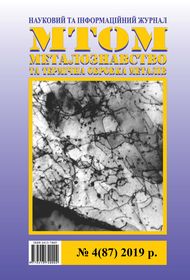Influence of non-metallic inclusions on the formation of the structure of the steel matrix in explosive loading
DOI:
https://doi.org/10.30838/J.PMHTM.2413.241219.36.598Keywords:
steel, non-metallic inclusions, pulsed loading, localization of deformation, stressesAbstract
Purpose. The goal of this work was to study the localization of deformation near inclusions in steels with various types of metal matrix and the behavior of the inclusions themselves under pulsed loading. Methodology. Dynamic loading of the samples of steels E3 and 08H18N10T was carried out according to the scheme of throwing a thin plate. The calculated pressure was80...90 GPa, strain rate 100 s-1, exposure time 1.5 · 10-6 s. The studies were carried out by several methods: metallographic ("Neophot-21"), electron microscopic (JSM-35). Findings. The features of local changes in the structure of the steel matrix near non-metallic inclusions under pulsed loading were studied. The processes of localization of deformation near inclusions in steels with various types of metal matrix and the behavior of the inclusions themselves under pulsed loading are discussed. The influence of the physical features of high-speed deformation on the formation of the structure of steels and the processes of its localization near inclusions were analyzed. It was established that stresses localized in a steel matrix near the inclusions cause their destruction. Scientific novelty. The analysis of plastic relaxation zones in a steel matrix was carried out, which made it possible to confirm the formation of regions with various orientations, which indicates a shear-rotational reorientation of these stress relaxation zones near inclusions as a result of plastic deformation having a wave nature. The general patterns of structure formation were determined and the influence of the crystal lattice type of the matrix of steels E3 and 08H18N10T on the development of localization of deformation processes near inclusions was shown. Practical relevance. Using the results obtained will allow us to develop pulsed pressure treatment regimes that allow you to influence the formation of the structure near non-metallic inclusions in various steels.
References
Epstein G.N. Stroyeniye metallov, deformirovannykh vzryvom [The structure of metals deformed by the explosion].Moscow : Metallurgy, 1988, 280 p. (in Russian).
Usherenko S.M., Gubenko S.I. and Nozdrin V.F. Izmenenie strukturi zheleza I stali pri sverhglubokom vnedrenii visokoskorostnih chastits [Changes in the structure of iron and steel with ultra-deep introduction of high-speed particles]. Metalli [Metals]. 1991, no. 1, pp. 124–125. (in Russian).
Usherenko S.M., Nozdrin V.F., Gubenko S.I. and Romanov G.S. Motion and deceleration of explosively accelerated solid particles in a metallic target. International journal of heat and mass transfer. 1994, no. 37 (15), рp. 2367–2375.
Sobolev V.V., Usherenko S.M. and Gubenko S.I. Fizicheskiy mekhanizm sverkhglubokogo pronikaniya mikrochastits v tverdyye sredy [The physical mechanism of superdeep penetration of microparticles into solid media]. Nauchnyy vestnik NKAU [Scientific Bulletin of NSAU]. 1998, no. 3, pp. 62–65. (in Russian).
Panin V.E., Likhachev V.A. and Grinyaev Yu.V. Strukturnyye urovni deformatsii tverdykh tel [Structural levels of deformation of solids].Novosibirsk : Nauka, 1985, 229 p. (in Russian).
Usherenko S.M., Gubenko S.I. and Nozdrin V.F. Izmeneniye struktury metallicheskoy misheni pri vysokoskorostnom vnedrenii dispersnykh chastits [Change in the structure of a metal target during high-speed penetration of dispersed particles]. Metallurgiya i termicheskaya obrabotka metallov [Metallurgy and heat treatment of metals]. 1991, no. 6, pp. 34–36. (in Russian).
Usherenko S.M., Gubenko S.I. and Nozdrin V.F. Dal'nodeystvuyushchiye polya napryazheniy vblizi dispersnykh chastits, voznikayushchiye pri vzryvnom legirovanii metallicheskikh materialov [Long-range stress fields near dispersed particles arising from explosive alloying of metallic materials. Metallophysics]. 1991, vol. 13, no. 7, pp. 57–64. (in Russian).
Nozdrin V.F., Usherenko S.M. and Gubenko S.I. Mechanism of hardening metals in superdeep penetration of high-speed particles. Physics and chemistry of materials treatment. 1991, no 6, р. 19–24.
Usherenko S.M., Gubenko S.I. and Sobolev V.V. Structural changes during the bulk doping of nuclear stainless steel. EUROMAT-96. Conference on materials and Nuclear Power.Bournemouth,UK, 1996, pp. 315–321.
Panin V.E. Volnovaja pripoda plasdtichekoj deformatsii tverdih tel [The wave nature of plastic deformation of solids]. Izvestija vuzov. Fizika [Izv. universities. Physics]. 1990, no. 2, pp.4–18. (in Russian).
Panin V.E., Meshcherjakov Yu.I., Yelsukova T.F.and Divakov A.K. Necryslallograficheskie structurnie urovni deformatsii v silnovozbuzhdennih sistemah [Non-crystallographic structural levels of deformation in highly excited systems]. Izvestija vuzov. Fizika [University News. Physics]. 1990, no 2, pp.107–120. (in Russian).
Gubenko S.I. Nemetallicheskiye vklyucheniya i plastichnost' staley [Non-metallic inclusions and ductility of steels. The physical basis of the ductility of steels]. Saarbrücken : LAP LAMBERT. Palmarium academic publishing, 2016, 549 p. (in Russian).
Gubenko S.I. Povedeniye nemetallicheskikh vklyucheniy pri vysokoskorostnoy deformatsii v usloviyakh vzryvnogo vozdeystviya [The behavior of non-metallic inclusions during high-speed deformation in explosive conditions]. Metallovedeniye i termicheskaya obrabotka metallov [Metallurgy and heat treatment of metals]. 1989, no. 1, pp. 40–41. (in Russian).
Gubenko S.I. Volny deformatsii vblizi nemetallicheskikh vklyucheniy v usloviyakh vzryvnogo vozdeystviya [Deformation waves near non-metallic inclusions in explosive conditions]. Metallovedeniye i termicheskaya obrabotka metallov [Metallurgy and heat treatment of metals]. 1992, no. 7, pp. 32–33. (in Russian).
Downloads
Published
Issue
Section
License
Authors that are published in this journal agree to follow the conditions:
Authors reserve the right to the authorship of his work and cede the right to the journal of first publication of this work on conditions of the license under the Creative Commons Attribution License, which allows others to distribute it freely with the obligatory reference to the author of the original work and the first publication of the work in this journal.

